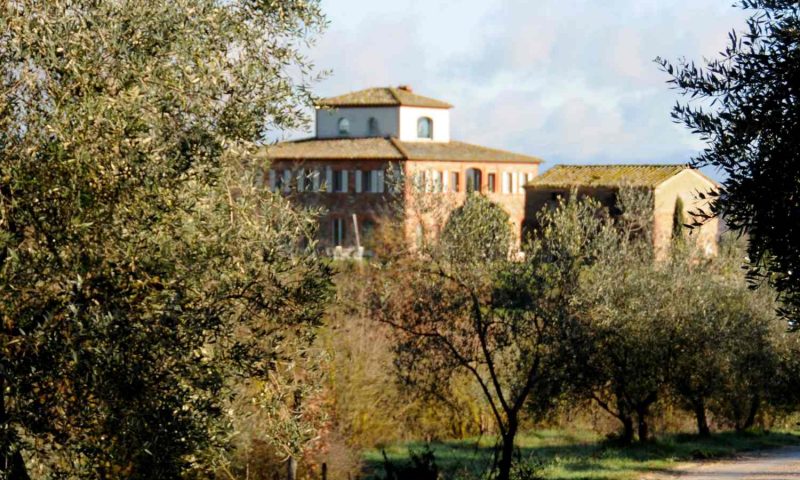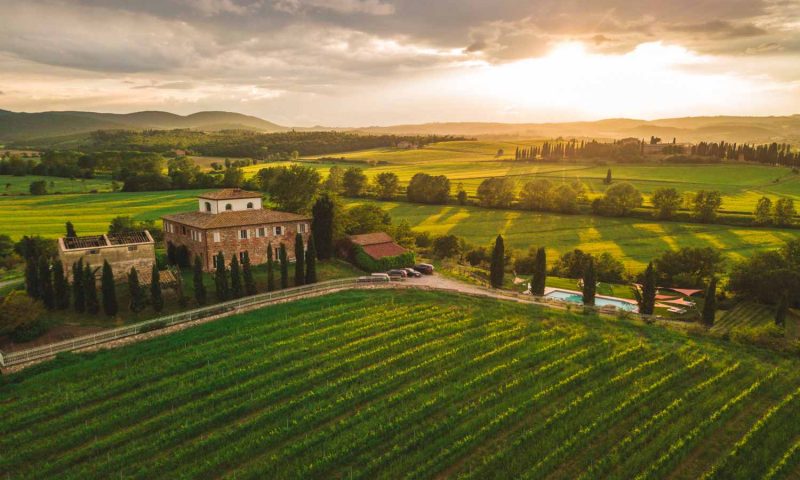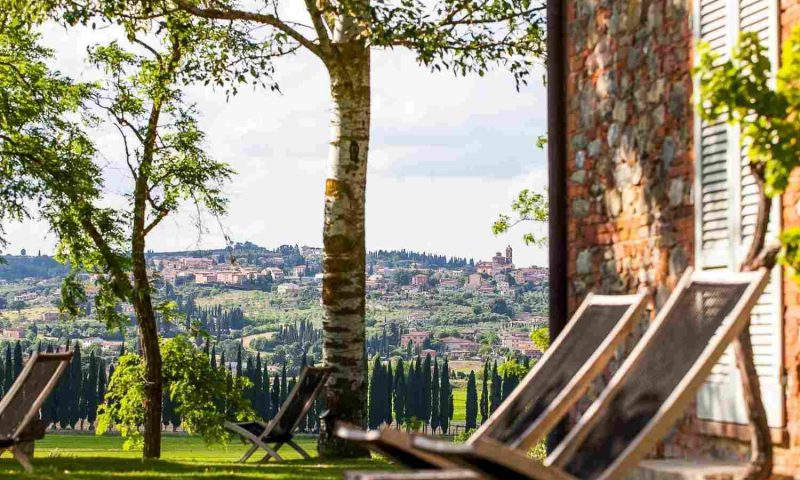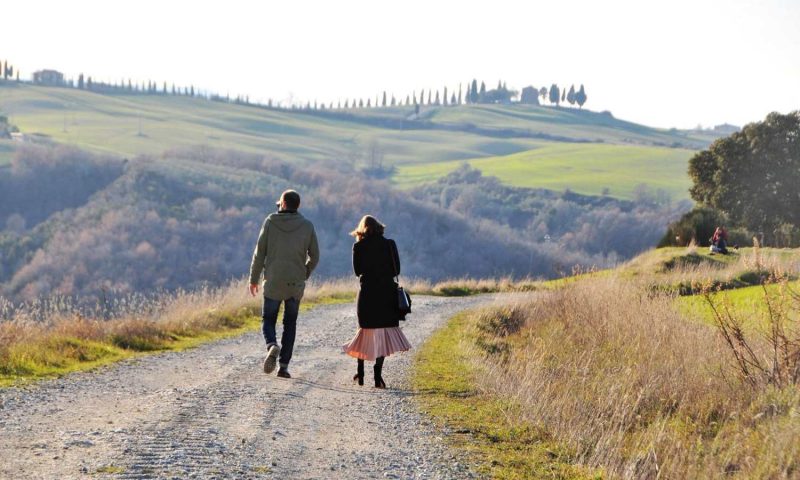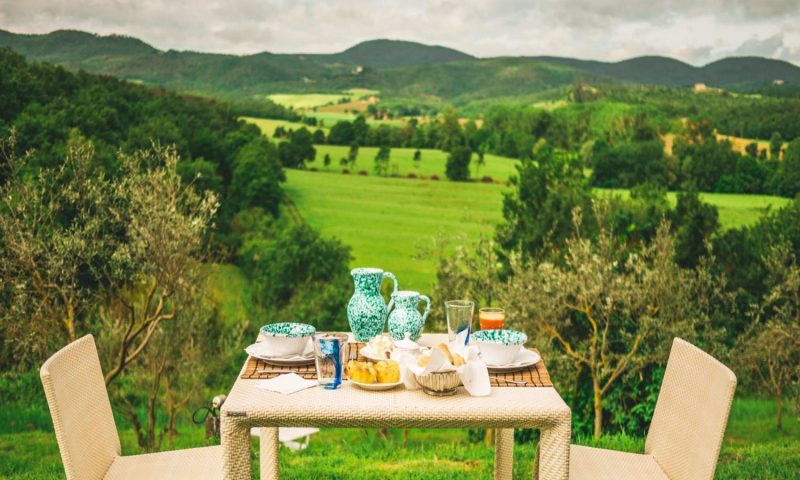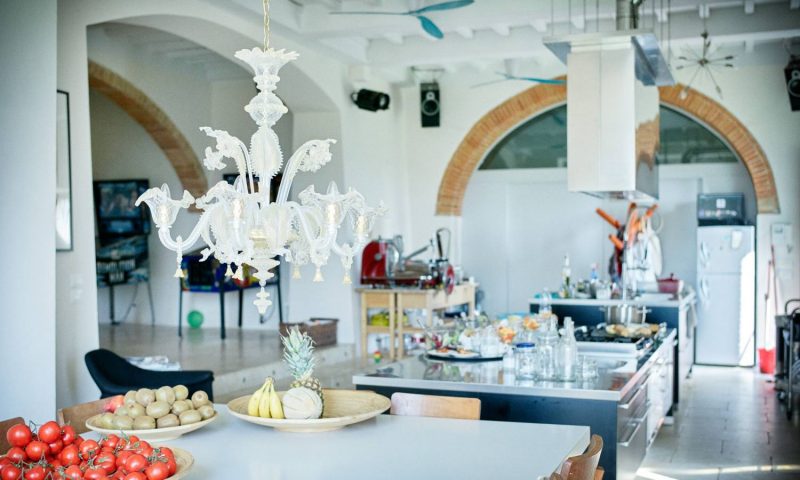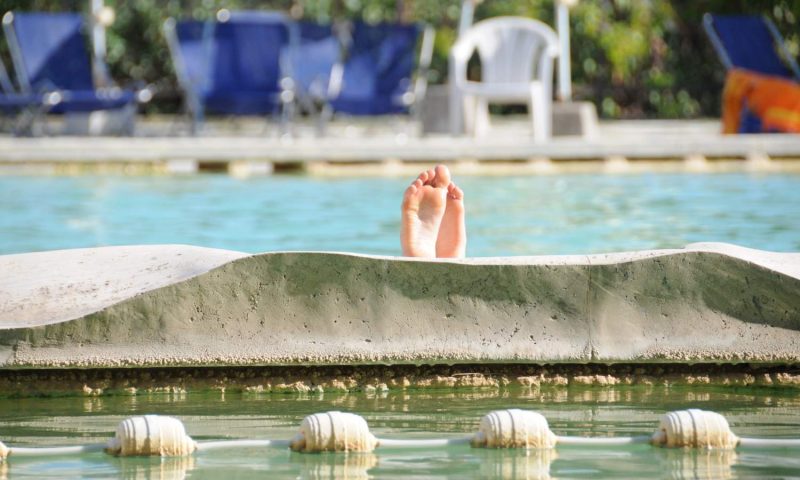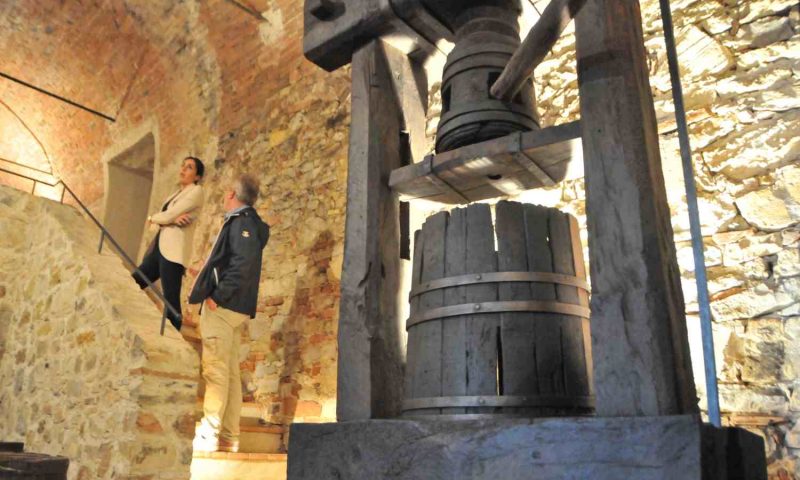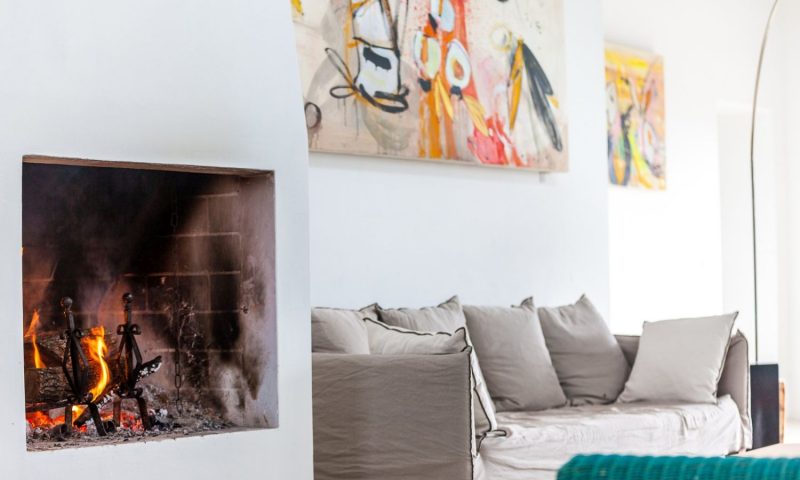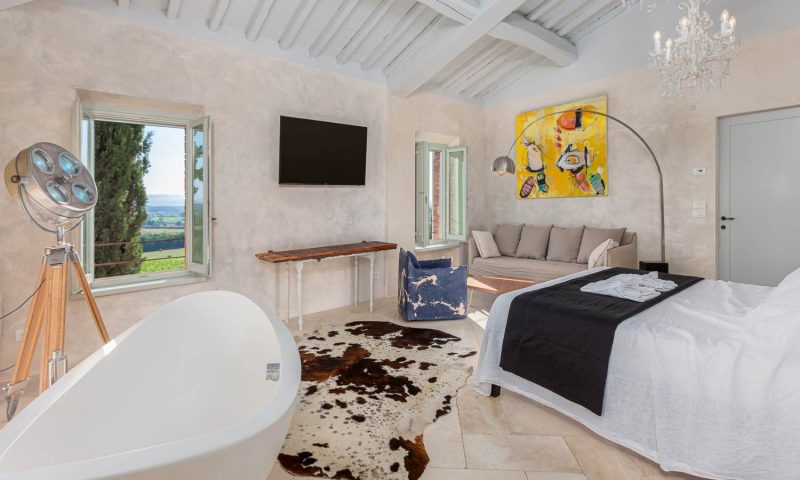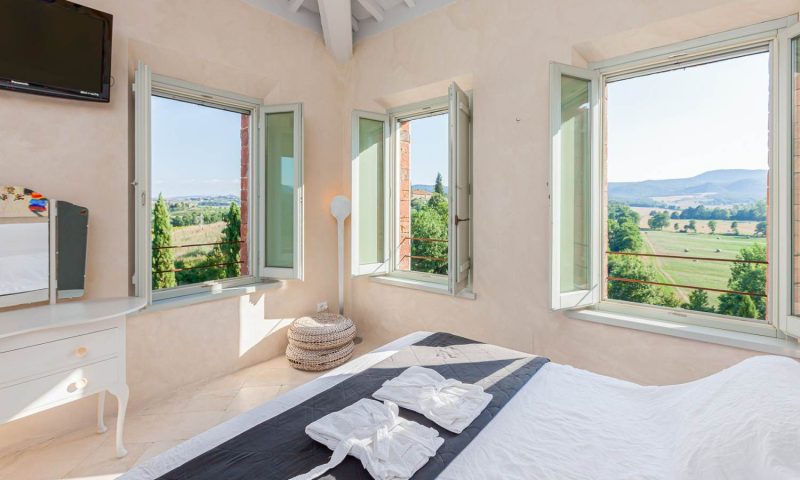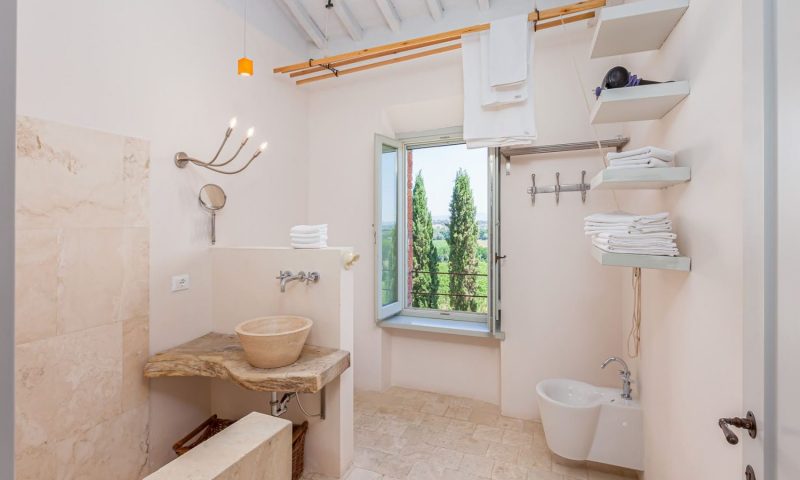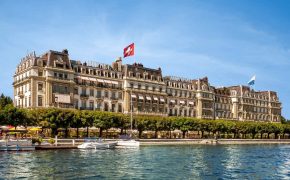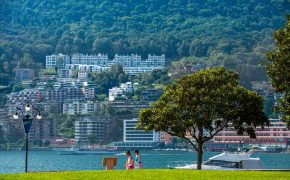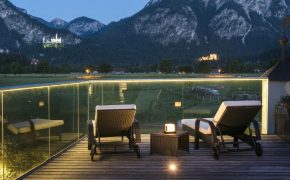Siena House is essentially a modernized villa in a panoramic position. Lawns circle the house, olive trees and saffron cover the terraced land below. A large, private pool and garden, and an independent kitchen are provided exclusively to our guests. Original art, designer double beds and furnishing and a generous naturally lit bathroom with open shower are common to all rooms. Some rooms have king-sized beds and large soaking tubs.
All have flat-screen TV +Netflix, high speed Wi-Fi, individual A/C, luxury linens and views. Situated between Cortona and Pienza, Florence and Rome; the location is strategic for exploring and offers excellent local services, wine and dining.
INSIDE
Modern might be too harsh a term to describe our interiors – particularly the bedrooms which are only softly modern, playful and atmospheric compositions that are beautiful and comfortable to spend time in.
Bathrooms are simple and luminous, in soft ‘whites’, with handmade stone vessel sinks Travertine floors and showers, and natural washstands, cut from a huge, splendid, slab of Oak, that we begged our carpenter to part with.
The large interior socializing areas are lighter, brighter and more art gallery-esque but throughout the property spirited, contemporary design, real art, and discreetly added technology, bring harmony and life to the spaces.
Historic items—like the lovely old farm chairs from the house’s former life, might be beautiful in their Artempo, time-altered states. They make wonderful pictures, but we don’t romanticize the artefacts from the houses’ heyday: Comfort was not a feature of the lives of the people who made or used them.
A MIX OF OLD & NEW
It was drive and passion (and of course money and time) that were required to bring light and comfort to the property. Opening windows, whitewashing dark ceilings, replacing dark floors and plastering the dark stony rooms that were the reality of the house.
THE TOWER LOUNGE
What a privilege and an adventure it was working on such a property! Decorated by an artist, the discerning eye will detect the quality of the interior at a glance—seeing beyond the image into the sensation of being here.
Conceived as a live-in Gallery; a place to experience Tuscany, to paint and to enjoy views and art, our vision was realized by local architect Marcello Bartolozzi, who was able to bring to life the dramatic opening of space that we desired.
Image showing a tuscan country house restored to boutique hotel with white interior decoration on walls ceiling and floor long low steel topped black kitchen units and large steel extraction hood there are several large window doors and one rich siena red arch over a dining table with sculpted ceramic base and eight chairs there is a black modern italian chair in the bottom right of the image and a murano chandelier over the table
EX GRANARY: THE MAIN KITCHEN
A big part was to open the whole of the ground floor—uniting the two main rooms (ex cow stalls + Granary on the ground floor) to make a huge open space. Upstairs, to achieve additional light and drama, the dovecot floor was removed, to give huge height to the central space.
Within the dovecot, we created a viewing gallery in glass and iron, with views over the hills and villages. The Gallery was the work of Roberto Cini, Local Master Carpenter, from Sinalunga. In 2016 the house was featured on the Christmas Special of France 5’s ‘La Maison’, Interior design and lifestyle show. In 2017 the house was the location for an episode of the U.K. reality T.V. show ‘Made in Chelsea’.
Word Of Mouth: Unpretentious, understated luxury, Contemporary Tuscan country house, light and spacious, decorated impeccably, fabulous pad in Tuscany, uniquely luxurious and relaxing place to stay
OUTSIDE
We have a large Saltwater Swimming Pool-almost 100m2, secluded from the house in a sheltered, scenic spot. The garden is simple; being outside is all about the views. Outdoors is rustic; the garden is simple with grass and woody herbs immediately around the villa, olive terraces and saffron, below, cypress trees upon entrance and rosemary framing the pool.
Shade over the South lawn, where we serve breakfast, at poolside and over the water is provided by Shade Sails that filter the U.V. light and are wind-proof. All Summer long, guests return home in time for sunset, when the best place to be is in the garden. There are many choice spots. For new arrivals to the house, the golden light of late afternoon – the final hour before the sun is gone – is unmissable. Try to get here in time to enjoy it.
BREAKFAST
The star of breakfast are our pastured eggs. Provided for us by mute ducks and bantam chickens, who enjoy a very high quality of life.
TUSCAN HERITAGE BREED BANTAMS
Fried in butter or Tallow, accompanied by Malvin’s home-smoked bacon, an ‘English Breakfast’ might be an unexpected offer, but certainly makes a great start to the day. More traditional for the area, pâtisserie fresh from the oven and an Italian coffee is, of course, available.
Breakfast is served from 9am on the lawns around the villa. Breakfast is accompanied by gourmet tea or 100% Arabica Coffee, locally roasted and expertly prepared on a full sized bar machine.
THE SPECIALITIES
Malvin began making his own bread back in 2007, and his interest grew from there through jam making, bread and cake baking, and beyond. Recently, Malvin has begun to salt cure and oak smoke high quality high welfare pancetta at the house, making an English style smoked bacon.
Magnificent served with butter or tallow fried grass fed eggs. Making many kinds of home baked bread and home produce fruit jams for years, often using our own fruit bottled, at its best, he has gradually become an excellent pastry chef, mastering several local specialities.
He makes his own live unsweetened yogurt and mascarpone, as well as chutneys and pickles. Above all, as the local bread is generally unsalted, Malvin’s salted bread is greatly appreciated: He has developed his skill in many styles of bread making including Celiac bread and pâtisserie.
THE PRODUCTS
The Agriturismo or farming aspect of the house is principally derived from our saffron and olive oil production. We have about 10,000 Saffron plants and around 150 Olive trees, all planted into the mediaeval terracing on the South and West sides of the bluff the house sits on.
In addition, we grow a few vegetables: Tomatoes and potatoes and a few Mediterranean vegetables (capsicum, aubergine, zucchini) onion, pumpkin, and cucumber. We enjoy freshly picked Basil [and other herbs] and keep a good amount of herbs around the villa.
Fruit-wise we have a small orchard with Apricot, Apple, Cherry, Fig Peach, Pear, Plum, and Quince as well as currents and a few melons. Our fruit is picked at its absolute best and transformed into preserves, which you’ll taste at breakfast.
THE SUMMER KITCHEN
A pretty, independent, double-equipped modern kitchen is available to guests. The Summer Kitchen, as we call it, is set a little away from the Villa, within an ex Pig Sty. Excellent for families, those following a special diet, and those who love to shop for local ingredients and cook in, this amenity gives a real ‘at home’ feel.
The Summer Kitchen is situated just a few steps from the main door of the villa, on the East corner of the garden. There will be shade from lunchtime for dining at the tables on the North lawn.
The kitchen is big enough for two couples to cook simultaneously, and is fitted with two full sets of equipment, including two entire kitchens. Two Weber BBQ and an illuminated private terrace are available, away from the bedrooms, for BBQ and dining after dark.
ABOUT THE VILLA
The structure is externally a fine and somewhat unusual example of a historic Tuscan farmhouse style, the Leopoldina. Named after Leopoldo, Grand Duke of Tuscany, whose design it was, the Leopoldina was conceived to be a new type of farmhouse, intended to provide a better quality of life to the farmworkers of the day.
Leopoldo’s innovation was to bring the housing of the Chianine, the Ox stalls, within the walls of the structure, that the first floor accommodations would benefit from the warming effect of the animals below.
Residing on the upper levels also brought some relief from the Mal Aria or Bad Air to the farmworkers, at least overnight. Bad air, during the time of Leopoldo, was the presumed cause of the disease that we now call Malaria, a problem in Tuscany at the time.
To complete the design, a handsome central tower or Colombaio was built into the roof. The idea was to attract the Colombacce or Collared Doves into residence within, as a source of food.
Leopoldo’s design is considered to have brought significantly better living conditions to the farmworkers from its inception in the 1750s. The building type is found principally within the Valdichiana Aretino but with a good number present, including this one, within the territory of the Valdichiana Senese.
Instantly recognizable, when touring this area, look for an imposing, often square structure with large, Oxen-sized doorways, pleasing symmetry, and a small tower built into the roof, and you’re probably looking at a Leopoldina.
THE HISTORY OF THIS LEOPOLDINA
This house would have been occupied by roughly 5 families/20 or so individuals, all working the surrounding land, all housed by and crop sharing with a landlord, a system that continued until the 1950s.
Back in the day, when the house was part of the Tenuta La Fratta, the organically farmed estate that surrounds us, several heads of Oxen or Chianine occupied the stalls at this property. The Chianine were ‘dressed’ for work in what is now the entrance hall.
They were also bred here:There was a nursery room on the south-west corner of the house where the calves were born. Following the end of the Mezzadria or sharecropping ere, in more recent times, the house was abandoned and fell into disrepair.
During the 70s and 80s it was used as a vantage point from which to observe the hunt and at the end of the 80s it was purchased by a gold trader from Arezzo who proceeded immediately to build a brick and stone wall that enclosed the entire hill, securely. With the collapse in gold prices a few years later, he was forced to sell his project, and the rest is our history.
ORNELIA’S STORY
Recently we have had the pleasure of meeting Ornelia Boscagli, who knows this house well since her childhood, and has told us of the people and animals that once lived here, the work of the house and surrounding fields.
Ornelia told us a story of wartime; during an oncoming air-raid German soldiers went out to collect the farm children, who were working away from their parents, and the Oxen, abandoned by their handlers in panic. The soldiers led the children, with chocolate, to cover in the forest nearby. Ornelia was about four years old and had never tasted chocolate before.
THE RESTORATION
At our arrival, the house was something of a started project and a bit of a mess. We removed all the recent additions, modifications made since the 1950s, leaving only the bare bones of the original rooms and divisions of the Leopoldina design, to contemplate and plan around.
We sat with the pared back structure, and eventually intervened very little division-wise, being rather taken by the glorious open spaces: The first floor of the house remains somewhat faithful to its original use, with a large open-plan living zone and a fireplace, central to 4 private corner accommodations.
At ground level, the granary and stalls we united, bringing the majority of volume at ground level into one continuous space. The house is not only a Leopoldina, but also a casa colonica meaning colonized dwelling, or a house that grew with its occupants.
More volume was constructed as more living space was required. The Leopoldina we see today was likely a reworking of a smaller, ancient property that is now the central part of the house.
ETRUSCAN ROOTS
Riccardo the Guardia Caccia (Gamekeeper) at Tenuta La Fratta, our neighbour, is a great source of local history and lore. He recently told us that the original dwelling place at this site predates the fall of the Roman Empire, and that the original name of this property Pietrabianca which means ‘white stone’.
It is thought locally that the name referred to the presence at this location of a site sacred to the Etruscans, built in white stone. Certainly, the central room of the house (shown in the image below) is the oldest ‘visible’ part of the building. Riccardo is convinced that there is something magnificent beneath!
The smaller, original dwelling was most likely surrounded by water on three sides, judging by Leonardo da Vinci’s maps of this area. In paintings dating from the 12-1300s we can see the house shown as a group of barn like structures.
The surrounding land is extremely fertile. At the time of the Etruscans, large parts of Tuscany were underwater, under a vast lagoon that was later drained by the Romans. But the waters rose over again in the Middle Ages, when a pope dammed a river near Orvieto for defensive purposes.
And so over the following 300 years the waters rose. Indeed, close by to our location, large areas were still wetlands until the time of Leonardo da Vinci—who drained the waters as the engineer to the Medici family, revealing vast areas of fertile land.
Our area is a historic centre for beef production and the zoological origin of the Chianina. The animals are visible from the windows looking out to the North, at La Fratta, where you will find the largest herd in Tuscany, grazing in the valley below. For those who love beef, or simply local specialities, dining at the local Toraia or bull house during your stay, comes highly recommended.
STRATEGIC LOCATION
Ours is a close-to away-from it all or strategic location: Central for Tuscany’s most wanted wines, landscapes and hilltowns, yet idyllic for staying home. From here, you can tour in earnest for several days and still not see all of our favourite local sights. But that’s the point: A strategic location means that you can be spontaneous.
Malvin spent 10 years scouring Tuscany and Umbria before buying here. The countryside is beautiful in this area, as are the hilltop towns, and hamlets, that circle us—we see seven from the house. Local towns include: Cortona, Lucignano, Montisi, Montepulciano, Montefollonico, and Pienza. Arezzo and Siena cities are each just over half an hour’s drive away.
Our location is also strategic for wine: we are at a hub point for 5 wine producing zones Chianti Classico, Nobile di Montepulciano, Orcia, Syrah of Cortona – and Brunello di Montalcino. Indeed, we welcome many wine lovers to the house (and have installed a professional wine refrigerator for bottles you bring home).
In this area, it’s still ‘real’ Tuscany: You can still enjoy authentic dishes at good prices in restaurants full of Italian diners—and very close by, too. We have 5 super places to dine out within 2 km of the house.
Some of the most photographed and filmed parts of Tuscany are within the Province of Siena and easy to reach: Gladiator, Quantum of Solace, The English Patient, Master of None, Made in Chelsea, and The Medicis have all included footage of the Province of Siena towns and countryside which is indeed varied and beautiful. Much of the new [2019] ‘Pinocchio’ was filmed at our ‘home farm’ La Fratta. Siena City on Palio Day
SIENA
A province as well as a city—the capital city is named Siena—often spelled Sienna. We’re part of the Commune of TORRITA DI SIENA within the Province of Siena. Siena City is about 35 minutes away. Siena is an unmissable visit whilst in the area but there are many visits much closer: Read about our favourite visits in our Tuscany Guide
FLORENCE & ROME
Florence is one hour North (without traffic delays) and Rome is 2 hours South (ditto) It’s a 10 minute drive to the motorway. This location has been an important stop for North-South travelers for centuries, and has a very interesting history but international tourism has not really arrived in number yet. Here at this location we’re also not too far from the province of Arezzo, including some gorgeous Chianti towns well worth visiting.
ITINERARIES
For guests spending 3-4 nights with us there is much, indeed too much, to see in terms of hill top villages, wineries, and landmarks within a short 25-25 minute journey. Local destinations are cited at our Tuscany Guide Pages After day 4-5, travelling further afield, beyond the immediate environs, might attract.
From this location you can also see Umbria with relative ease: Starting at 20+ minutes away you can get deep into UMBRIA with a 45 /+ minute drive. PERUGIA (useful airport location at 55 mins) Perugia is both a province and City.
The City of Perugia is the capital of Umbria is about an hour away. Beyond Perugia, at about 80 minutes drive is ASSISI. Starting at 20+ minutes away, you can get deep into CHIANTI in an hour. A drive to SAN GIMIGNANO, beyond Siena City, will take about 80 minutes.
You could get to VOLTERRA in an hour and a half. PISA & LUCCA are just over 2 hours. ORVIETO, roughly one hour is an oft missed but splendid visit, convenient for those going to or coming from Rome. A day trip to FLORENCE (just over an hour away) is certainly not out of the question, either.
Those are the Big Name visits, but we suggest that spending time exploring in a half hour radius from the house is wonderful, and we would not encourage driving much further away unless on a 4-5 night’s stay at least.
We are always happy to help you with your planning and to put the brakes on your ambition; in this area the journey is generally equal to the destination in terms of enjoyment and so don’t plan in too much.
HOW TO GET AROUND
Without question, the best way to enjoy the Tuscan Countryside is by car—your ‘own’ car. Roads are mostly very quiet and driving can be very enjoyable. Nothing beats the spontaneity and independence offered by a rental car, and we will help with parking spots and journey plans or in any way we can.
For the frequent wine question, ‘Do we need a driver when going wine tasting’, oft asked, possibly the best way to wine taste in this area is to go ‘pro’ and go slow: Mix one winery into each day of your stay, don’t drink but sip-and-spit, and bring something back to the house to enjoy.
In this area wine tastings are often conducted by the maker, accompanied by plenty of insight and can be quite personal. You are not expected to actually drink the wine in the winery!
